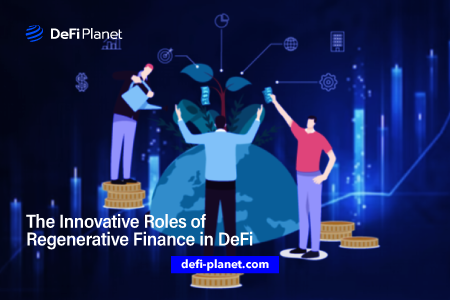To set the stage for this discussion, let’s first define some key terms:
- Innovative: ‘characterized by the creation of new, forward-looking ideas or inventions’.
- Regenerate: ‘to reconstruct or create anew, especially in an improved manner, or to revitalize something’.
- Finance: ‘the management of money, monetary resources, and other similar assets’.
Cryptocurrency and Decentralized Finance (DeFi) were created with the primary goal of revolutionizing the traditional banking and finance system and providing democratized access to finance. However, in today’s crypto space, it seems that the focus on revolution, decentralization, and innovation has been lost. We’re now repeating the same mistakes made by key players in traditional finance years ago.
Crypto users and even businesses built on the primary idea of Decentralized Finance (DeFi) now tend to view the industry as a “get rich quick” scheme, where they can make a quick buck without providing any substantial value or resorting to unethical practices that may undermine customer trust. Recent events involving crypto companies like FTX and Bitzlato are clear indications of this concerning trend.
This, however, is where Regenerative Finance (ReFi) in DeFi and the larger Web3 space steps in; as a knight in shining armour. ReFi takes us back to the drawing board. It aims to reverse the focus of crypto activities back to its status quo of tackling real-life problems with innovative technologies and economically beneficial incentives.
In simpler terms, ReFi enables us to use blockchain and other innovative Web3 technologies to solve real-world problems while still reaping monetary benefits. It’s a win-win situation!
In this article, we will explore the nature and concept behind ReFi, as well as the innovative utilities it offers the Decentralized Finance industry through blockchain technology.
Let’s start with the basics:
What is ReFi?
ReFi is an innovative economic model that recognizes and rewards people for their contributions to society. ReFi acknowledges that maintaining a healthy environment involves having a flourishing community. ReFi offers monetary incentives that encourage individuals to engage in activities that combat global issues like climate change.
The emergence of blockchain technology has led to several discoveries that can significantly improve the quality of life. Imagine having the opportunity to earn more money by preserving a rainforest or reforesting empty lands instead of cutting down timber or using such lands for farming. Would you not prefer the option that puts money in your pocket?
Furthermore, ReFi prevents the loss of biological diversity by enabling consumers to place a monetary value on concepts such as habitat restoration, using digital assets such as assets backed by carbon from the environment.
ReFi, therefore, suggests that the higher the value and incentives for biodiversity and cleaner environments are, the more assets there are in circulation.
The Origin of Regenerative Finance (ReFi)
ReFi is a new concept that merges two distinct disciplines, regenerative economics and decentralized finance (DeFi). Economist and philosopher John Fullerton coined the term “regenerative economics” in a 2015 paper titled “Regenerative Capitalism.” He defines this economic model as one that maximizes value to communities by regenerating what has been lost, conserving what remains, and ensuring long-term financial prosperity.
Fullerton proposed eight guiding principles in his paper, known as the “Principles of Regenerative Economy,” to support and create a new financial and economic system that would produce equal prosperity for all. These principles include Robust Circulation, Empowered Participation, Innovative, Adaptive and Responsive, and Holistic View of Wealth.

ReFi is founded on these Principles of Regenerative Economics, aiming to create a system that restores and sustains the physical resources necessary for the well-being of all, and it uses monetary incentives to encourage actions that aid in renewing these natural resources and benefiting the world’s ecosystem.
Though Fullerton’s Regenerative Economics theory did not explicitly mention cryptocurrencies, its principles can also apply to how we think about DeFi. DeFi seeks to revolutionize and democratize access to financial services without intermediaries, and this aligns with the goals of Regenerative Economics.
The ReFi concept seeks to disrupt traditional finance systems and create a financial ecosystem that offers sustainable financial services and opportunities for all. By combining the basic tenets of DeFi, ReFi aims to create a financial system that serves society while taking care of the environment.
Why ReFi?
The goal of ReFi is to help users redefine their relationship with the current financial system as well as their personal wealth levels. It has also been said that ReFi can redefine what money means and how it’s used, thus helping people change the way they relate to money.
ReFi intends to bring awareness to the exploitative nature of the present financial systems, which are no longer appealing, and introduce financial models and systems that can increase equal access and distribution of wealth.
Is ReFi the Future of DeFi?
The desire for a new and regenerative economy espouses the undeniable need to delve into emerging technologies like DeFi.
Refi and DeFi are both aimed at developing accessible financial marketplaces and addressing the limitations of the traditional financial system. However, Refi projects go further to address socio-economic development areas.
Although the idea of a Refi economy is still in its early stages, DeFi projects have already started incorporating ReFi ideologies. The ReFi model also adopts some systems used in DeFi, like blockchains, standardized tokens, decentralized exchanges (DEX), and even Decentralized Autonomous Organizations (DAOs). These systems provide governance tokens that allow every member to contribute and determine the direction of the project as stakeholders.
For example, DAO Projects like Celo and KlimaDAO have ReFi strategies integrated into them. Celo aims to create better living and monetary conditions for everyone by providing a financial system that allows bankless people with access to mobile phones to enjoy financial services. Celo achieves this through the Phone Identity System (PIS), a service that uses validators to prove that new users can connect their wallet addresses with their phone numbers, allowing them to trade crypto assets with one another through their phone numbers.
Similarly, KlimaDAO aims to solve the real-world problem of climate change by financing globally sustainable projects to build a new green economy.
However, for DeFi products to flourish in a prospective ReFi economy, they must provide novel utilities that cater to specific socio-economic issues.
Nonetheless, the continued romance of DeFi and ReFi indeed holds prospects that would launch the DeFi industry into deeper levels of forward-thinking solutions to world issues through more innovative technologies.
The Relationship Between ReFi and Web3
Similar to the DeFi industry, there are also Web3 infrastructures that utilize ReFi principles to bring about positive changes on a global scale and extend Web3 benefits to other sectors.
One prominent example is the tokenization of natural assets. Thanks to NFTs and smart contract technology, Web3 has evolved to the point where virtually anything can be tokenized. When natural assets such as land, gold, or gas are tokenized, individuals equipped with a wallet and the necessary Web3 or DeFi application can trade or invest in these tokens from anywhere in the world.
Furthermore, the Web3 industry has initiated the growth of ReFi projects. With the current emphasis on sustainable practices in nearly every sector worldwide, the ReFi ecosystem is poised for massive growth in the years ahead.
In Conclusion
- Regenerative Finance, also known as ReFi, is a movement that aims to tackle climate change, environmental conservation, and other socio-economic challenges by utilizing blockchain and DeFi technologies. ReFi has already made significant strides in the DeFi and Web3 industries. For instance, certain DAO projects such as Celo, and natural asset tokenization through NFTs infrastructure, have implemented innovative technologies for positive and sustainable objectives.
- Besides the progress made so far, ReFi’s potential for impact is enormous. By leveraging decentralized finance and blockchain technology, ReFi has the potential to revolutionize the financial sector as we know it today. It can provide a framework for financial systems that prioritize social and environmental impact while still delivering financial returns. Additionally, ReFi can promote access to financial services and products for marginalized communities, reduce inequality, and create new opportunities for investment and participation.
- The principles of regenerative finance, in combination with the innovative capabilities of DeFi, have the potential to drive a shift toward a more sustainable and equitable global economy faster than anticipated.
Disclaimer: This article is intended solely for informational purposes and should not be considered trading or investment advice. Nothing herein should be construed as financial, legal, or tax advice. Trading or investing in cryptocurrencies carries a considerable risk of financial loss. Always conduct due diligence.
If you would like to read more articles like this, visit DeFi Planet and follow us on Twitter, LinkedIn, Facebook, and Instagram, and CoinMarketCap Community.
“Take control of your crypto portfolio with MARKETS PRO, DeFi Planet’s suite of analytics tools.





















